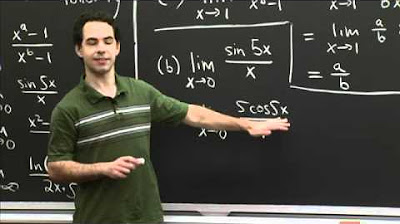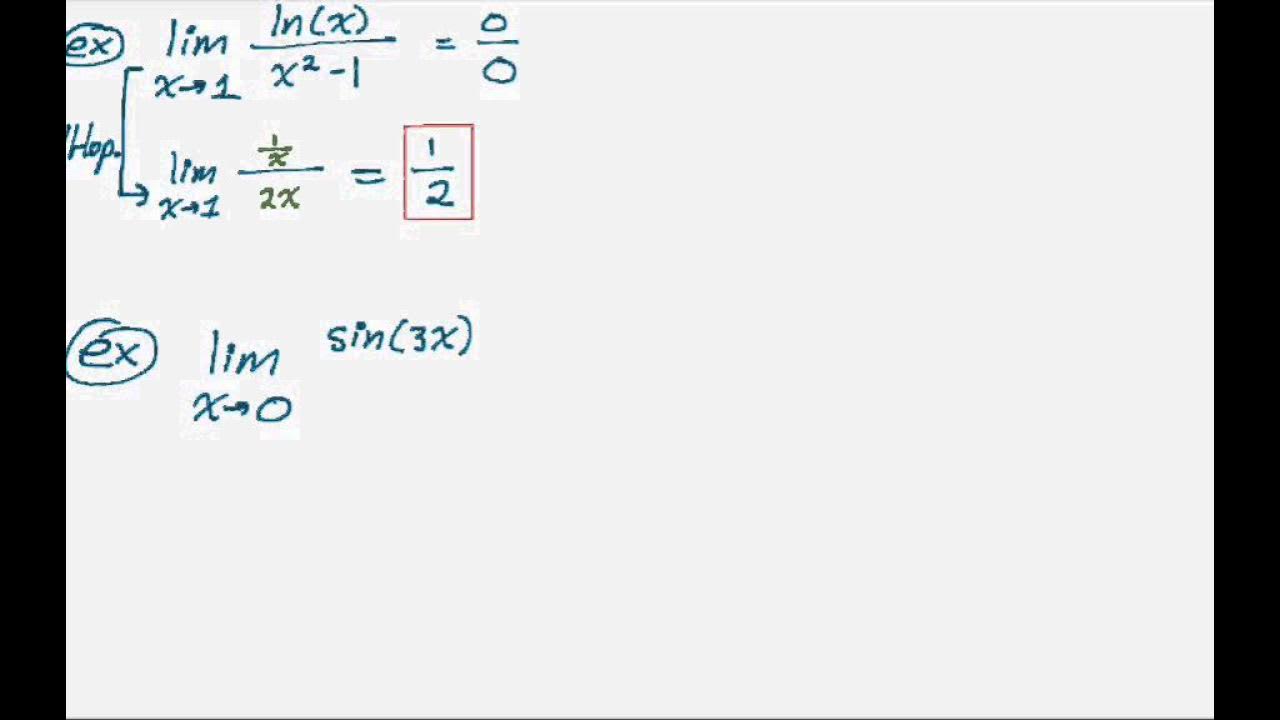Calculus Chapter 1 Lecture 8 l'Hopital's Rule
TLDRIn this calculus lecture, Professor Greist introduces and explains l'Hôpital's Rule, a method for evaluating tricky limits, particularly those of the indeterminate form 0/0 or ∞/∞. The professor clarifies the correct application of the rule, emphasizing the importance of understanding why it works rather than just applying it. Through examples, he demonstrates how differentiation of the numerator and denominator can simplify limit problems and provides insights into the rule's effectiveness and its relation to Taylor series expansions. The lecture also touches on the use of l'Hôpital's Rule for limits at infinity and sets the stage for studying asymptotics and growth rates of functions.
Takeaways
- 📚 L'Hôpital's Rule is a popular method in calculus for evaluating limits, especially when faced with indeterminate forms like 0/0 or ∞/∞.
- 🔍 The rule states that if the limit of the ratio of two functions results in an indeterminate form, you can differentiate the numerator and denominator and re-evaluate the limit.
- 🚫 It's a common mistake to apply L'Hôpital's Rule without first attempting to evaluate the limit directly; this can lead to unnecessary complexity.
- 📈 The rule's effectiveness is based on the cancellation of lower-order terms in the Taylor expansions of the numerator and denominator, leaving the leading terms which are the derivatives evaluated at the point of interest.
- 📉 L'Hôpital's Rule can be applied iteratively if the first application does not resolve the indeterminate form, by differentiating again and re-evaluating.
- 📘 The script provides examples of applying L'Hôpital's Rule, such as the limit of sin(x)/x as x approaches 0, which simplifies to the derivative of cos(x)/1, yielding a limit of 1.
- 📊 The script contrasts L'Hôpital's Rule with Taylor series expansion, showing that sometimes L'Hôpital's Rule is more straightforward to apply, especially when Taylor series are not easily remembered or are complex.
- 🤔 The script also discusses limits that do not directly fit the 0/0 or ∞/∞ form, like 1/sin^2(x) - 1/x^2 as x approaches 0, and how to manipulate them to make L'Hôpital's Rule applicable.
- 🔢 The importance of understanding the growth rates of functions is highlighted, with L'Hôpital's Rule and Taylor series being tools to evaluate these rates, leading to the concept of Big O notation.
- 💡 The script suggests that L'Hôpital's Rule can be used to evaluate limits at infinity, demonstrating how the rule can show that the ratio of log(x) to the square root of x approaches 0 as x goes to infinity.
- 🔄 The script warns against the misuse of L'Hôpital's Rule in cases where it leads to a loop, such as with the hyperbolic tangent function, and suggests using other methods or definitions to find the limit.
Q & A
What is l'Hôpital's Rule used for in calculus?
-L'Hôpital's Rule is used for evaluating limits that involve indeterminate forms, particularly when the limit results in a 0/0 or ∞/∞ situation, by differentiating the numerator and denominator repeatedly until a determinate limit can be found.
Why do some students incorrectly apply l'Hôpital's Rule?
-Some students incorrectly apply l'Hôpital's Rule by differentiating as soon as they see a limit that looks like a quotient without first checking if the limit can be evaluated directly, which can lead to unnecessary work or incorrect results.
What is the correct procedure when applying l'Hôpital's Rule?
-The correct procedure is to first try to evaluate the limit directly. If unsuccessful, differentiate both the numerator and the denominator and try again. Repeat this process until a determinate limit can be found.
How does the script explain the rationale behind l'Hôpital's Rule?
-The script explains the rationale by using Taylor expansions to show that when the limit of both the numerator and denominator is zero, the zeroth order terms vanish, and the leading order terms involve the derivatives evaluated at the point of interest.
What is the example given for a limit that simplifies using l'Hôpital's Rule compared to a Taylor series?
-The example given is the limit as X goes to 0 of tangent of X over arc sine of X. Using l'Hôpital's Rule simplifies the process compared to recalling or deriving the Taylor series for tangent and arc sine.
Why might l'Hôpital's Rule not be the best approach for some limits?
-L'Hôpital's Rule might not be the best approach when the derivatives of the functions involved are complex or when the limit does not fit the 0/0 or ∞/∞ indeterminate forms, making Taylor expansions or other methods more suitable.
Can l'Hôpital's Rule be used for one-sided limits?
-Yes, l'Hôpital's Rule can be used for one-sided limits, as demonstrated with the example of x times log of X as X approaches zero from the right.
How does the script illustrate the use of l'Hôpital's Rule for limits at infinity?
-The script illustrates this by applying l'Hôpital's Rule to the limit as X goes to infinity of log of X over the square root of X, showing that the ratio goes to zero as the square root grows faster than the logarithm.
What is the script's final example involving hyperbolic functions and l'Hôpital's Rule?
-The final example considers the limit as X goes to infinity of the hyperbolic tangent of X, which initially seems to get stuck in a loop when applying l'Hôpital's Rule. However, by considering the definition and growth of exponential functions, the limit is found to be 1.
What additional tool is mentioned in the script for studying the growth rates of functions?
-The script mentions Big O notation as an additional tool for discussing or controlling the growth of functions, which will be introduced and used in studying asymptotics.
Outlines
📏 Introduction to L'Hopital's Rule
Professor Greist introduces L'Hopital's Rule, a method used in calculus for evaluating tricky limits. The rule involves differentiating the numerator and the denominator when faced with an indeterminate form like 0/0. The explanation includes examples such as the limit of sin(x)/x as x approaches 0 and the concept that repeatedly applying the rule can yield the correct limit.
🧮 Applying L'Hopital's Rule and Taylor Series
The discussion continues with more complex examples where L'Hopital's Rule and Taylor series expansion are used. Examples include the limits of expressions involving trigonometric and logarithmic functions, like tangent(x)/arcsin(x) and x^2 * log(cos(x))/sin^2(3x). The steps show how to handle indeterminate forms by simplifying using Taylor series expansions and differentiate to find the limit.
🔄 Handling Complex Indeterminate Forms
This section explores cases where indeterminate forms like infinity - infinity or 0 * infinity occur. By rearranging expressions and using common denominators or applying L'Hopital's Rule, the discussion shows how to resolve these limits. An example involving x * log(x) as x approaches 0 from the right is examined, highlighting the use of L'Hopital's Rule when Taylor expansions are not straightforward.
📉 L'Hopital's Rule for Limits at Infinity
The focus shifts to using L'Hopital's Rule for evaluating limits at infinity. An example is provided with the limit of log(x)/sqrt(x) as x goes to infinity, illustrating how one function can dominate another in growth rate. The section also mentions the hyperbolic tangent function and its limit behavior, leading to a discussion on the growth rates of functions and the introduction of the Big O notation as a tool for describing these rates.
Mindmap
Keywords
💡L'Hôpital's Rule
💡Indeterminate Form
💡Differentiation
💡Taylor Series
💡Limit
💡Derivative
💡Factoring
💡Leading Order Terms
💡Asymptotics
💡Big O Notation
Highlights
Introduction to L'Hôpital's Rule and its popularity among students of calculus.
L'Hôpital's Rule as a method for evaluating tricky limits, especially 0/0 indeterminate forms.
The correct application of L'Hôpital's Rule involves differentiating the numerator and denominator until the limit can be evaluated.
Common mistakes students make when applying L'Hôpital's Rule without proper conditions.
The theoretical explanation of why L'Hôpital's Rule works, using Taylor expansion.
Example of applying L'Hôpital's Rule to the limit of sine(x)/x as x approaches 0, resulting in the answer 1.
Illustration of the process using Taylor expansions to understand the cancellation of terms and the focus on leading order terms.
Demonstration of L'Hôpital's Rule on the limit of (1 - cos(x))/x as x approaches 0, leading to an answer of 0.
Comparison of L'Hôpital's Rule with Taylor series for evaluating limits, showing the simplicity of the former in certain cases.
Application of L'Hôpital's Rule to the limit of tan(x)/arcsin(x) as x approaches 0, yielding an answer of 1.
Example where L'Hôpital's Rule might not be the best approach, illustrating the complexity of derivatives involved.
The use of Taylor expansions as an alternative to L'Hôpital's Rule in evaluating certain limits.
Explanation of limits that are not in the 0/0 indeterminate form, such as 1/sin^2(x) - 1/x^2 as x approaches 0.
Application of L'Hôpital's Rule to the limit of x*log(x) as x approaches 0 from the right, resulting in an answer of 0.
Evaluation of limits at infinity using L'Hôpital's Rule, such as log(x)/sqrt(x) as x approaches infinity.
The concept of limits at infinity and how L'Hôpital's Rule can be applied to understand the growth rates of functions.
The issue with applying L'Hôpital's Rule to the limit of tanh(x) as x approaches infinity, leading to a loop.
Introduction to the concept of Big O notation as a tool for discussing the growth rates of functions, in addition to L'Hôpital's Rule and Taylor series.
Conclusion highlighting the utility of L'Hôpital's Rule and Taylor series in evaluating limits and the upcoming study of asymptotics.
Transcripts
Browse More Related Video

Lec 35 | MIT 18.01 Single Variable Calculus, Fall 2007

Using L'Hopital's Rule to show that exponentials dominate polynomials

Example of Using L'Hopital's Rule Twice to Evaluate a Limit

l'Hospital Practice | MIT 18.01SC Single Variable Calculus, Fall 2010

Lesson 5 - L'hopitals Rule (Calculus 2 Tutor)

L'Hopital's Rule Examples
5.0 / 5 (0 votes)
Thanks for rating: